Pantry staples are basic ingredients that most people always keep on hand. They are usually dried ingredients that have a long shelf life, but can also include refrigerated/frozen ingredients that you use often. Below, I have compiled a list of about 35 of my favorite pantry staples that I use regularly in my vegetarian kitchen. When you have a well stocked pantry, the hope is that you should be able to easily use a combination of those ingredients to make a few healthy meals. This idea can help save money and assist in meal planning.
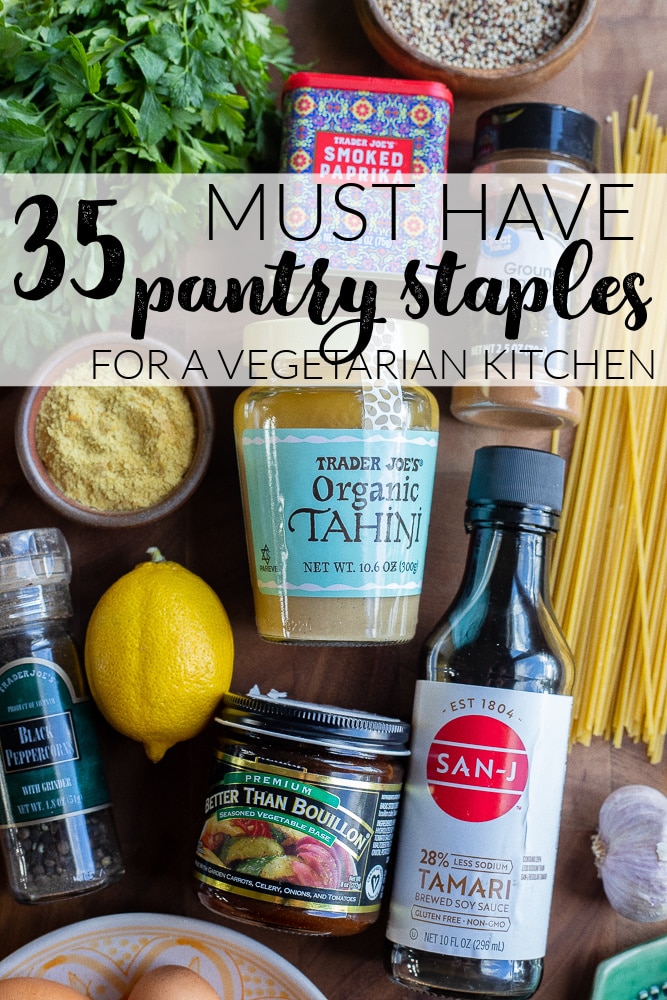
I’ve been wanting to share this vegetarian pantry staples post for a while now and I’m so excited that it is finally finished. I share a lot of recipes that claim they are made using “pantry staples” so I thought it would be helpful if I actually shared what I view to be pantry staples in my house. Everyone is different, so something I use all the time may not get used at all in someone else’s house, but I think this list is a good starting point if you want to get your kitchen stocked up!
What Are Pantry Staples?
Pantry staples are basic ingredients that are regularly used in a household. Ingredients that you use in everyday cooking and that you keep well stocked at all times of the year. I also like to think of them as being ingredients that if kept well stocked, you should be able to put them together in different ways to make healthy meals, without having to buy too many extras. This list includes a lot of ingredients that are shelf stable and last a long time, but I have also included ingredients that do need refrigeration. Below you will find 35 pantry ingredients that I think are essential in my everyday vegetarian cooking. Let me know if you think I missed any!
*Below are photos of ingredients that I currently have at home. But, just because it is in a photo, doesn’t necessarily mean that that is the only brand of product that I use. I shop at multiple grocery stores, but lately have been sticking to the ones with the cheapest prices. Let me know if you have any questions about specific products!
PANTRY STAPLES
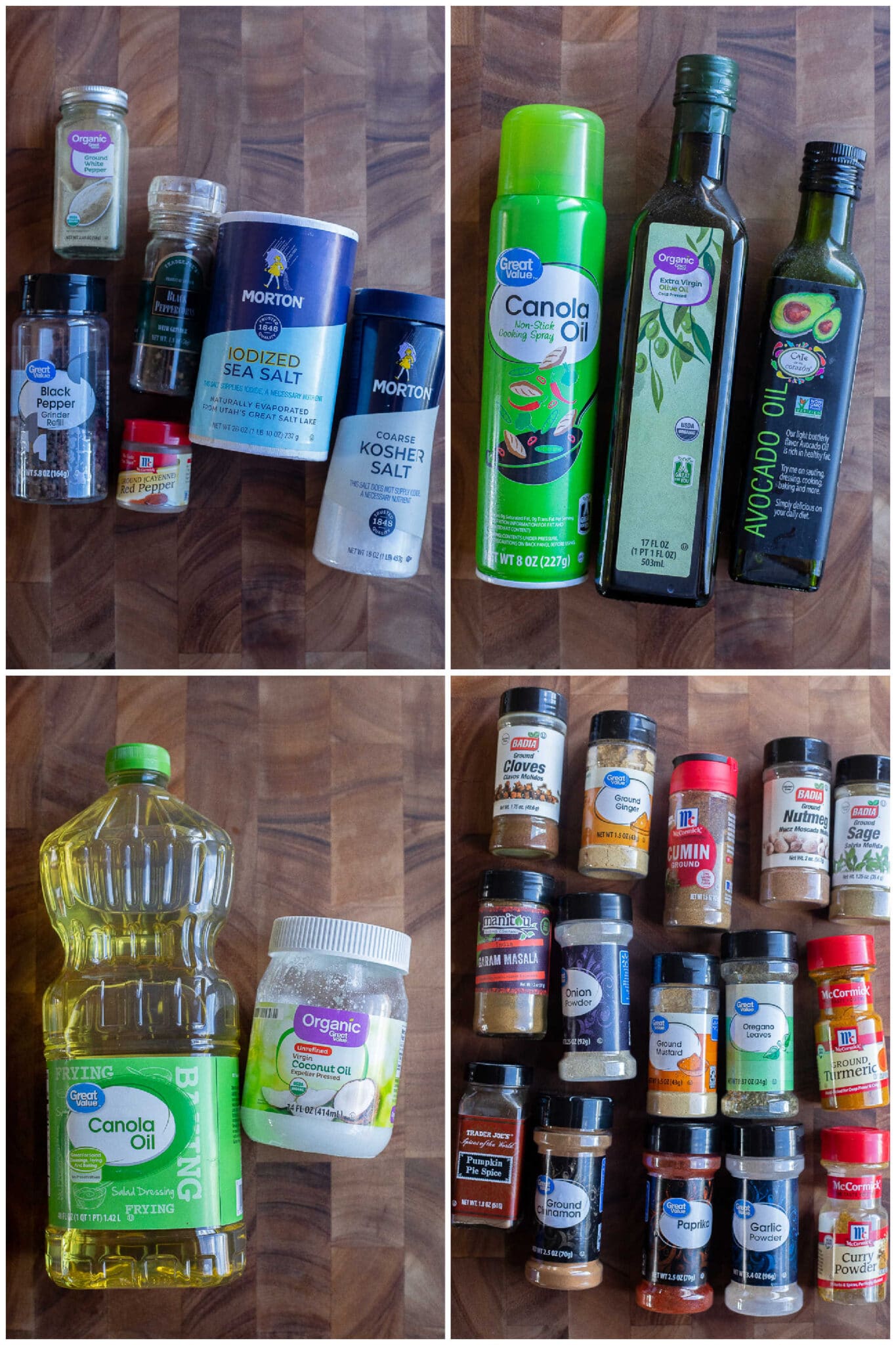
SALT + PEPPER
There are many different types of salt and pepper out there, but for most at home cooks, table salt and black pepper are most important. I prefer to use an iodized salt (because I have low iodine issues) and freshly cracked black pepper. I do have white pepper in my pantry, but rarely use it.
I use salt and pepper in pretty much all of my recipes. Salt not only adds saltiness, but it also helps enhance other ingredient flavors and even helps break down veggies quickly, when cooking them. Pepper is spicy and can add a nice kick to your meals. Red pepper flakes can also be used instead of regular black pepper.
OIL
The main oils that I use in my everyday cooking are olive oil, avocado oil, canola oil and toasted sesame oil.
Oil is used for many different things, including: sautéing, roasting, making salad dressing, sauces, deep frying, baking or even just drizzling a good oil over a finished meal. I would recommend finding a basic cooking oil that you enjoy and using that most often.
DRIED SPICES
In my opinion, dried spices are a must have ingredient in your kitchen. I like to keep a well stocked spice drawer including all the common spices, plus a few uncommon ones that I enjoy using. Dried spices can help add so much flavor to your dishes, without adding extra fat. My most used spices are probably cumin, granulated garlic, paprika, cinnamon and onion powder.
I used dried spices in almost all of my recipes and would recommend that you have a fully stocked collection as well. Dried spices can be used in all types of cooking including, baking, roasting, marinades and sautéing. They add tons of flavor and tend to be much stronger in flavor than their fresh counterparts.
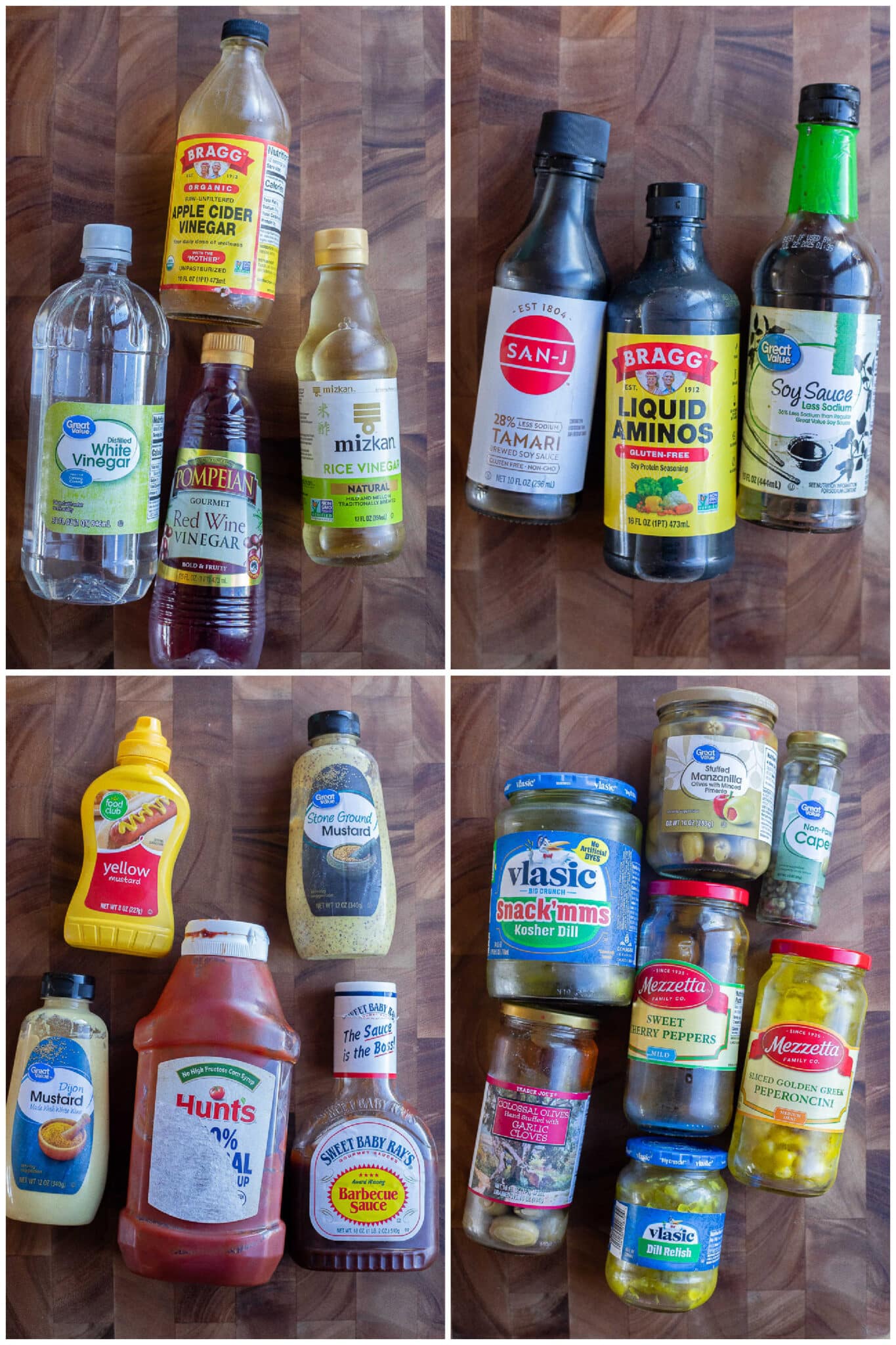
VINEGAR
I love vinegar and always try to have a few different kinds on hand. The vinegars that I usually keep stocked are: red wine vinegar, balsamic vinegar, rice wine vinegar, apple cider vinegar and white distilled vinegar.
Vinegars can be used in many different ways, including salad dressing, sauces, marinades, pickling, preserving, cleaning fruits and veggies and even for regular household cleaning needs.
TAMARI/SOY SAUCE
Tamari and soy sauce are both Asian ingredients that are made from fermented soy beans. They’re liquids that are dark in color and salty in taste. I use tamari in sauces, marinades, dressings or just as a liquid form of salt.
Products like liquid aminos and coconut aminos can also be used interchangeably with soy sauce and tamari in recipes. Soy sauce contains wheat and is not gluten free, but the rest are.
KETCHUP/MUSTARD/BBQ SAUCE
Ketchup and mustard aren’t just for hotdogs and hamburgers, they can also be used to add depth of flavor to recipes like sauces, marinades, soups and glazes.
There are a few different types of mustards, but I probably use dijon mustard the most. It helps thicken and flavor salad dressings and sauces.
PICKLED VEGETABLES
If you’re like me, you have a well stocked section in the refrigerator for your favorite pickled vegetables. I probably use pickled jalapeños most often, but also enjoy regular pickles, pepperoncinis, pickled onions and pickled garlic. They can be added into recipes or used as a refreshing garnish. I am also including olives in this category, if you like them.
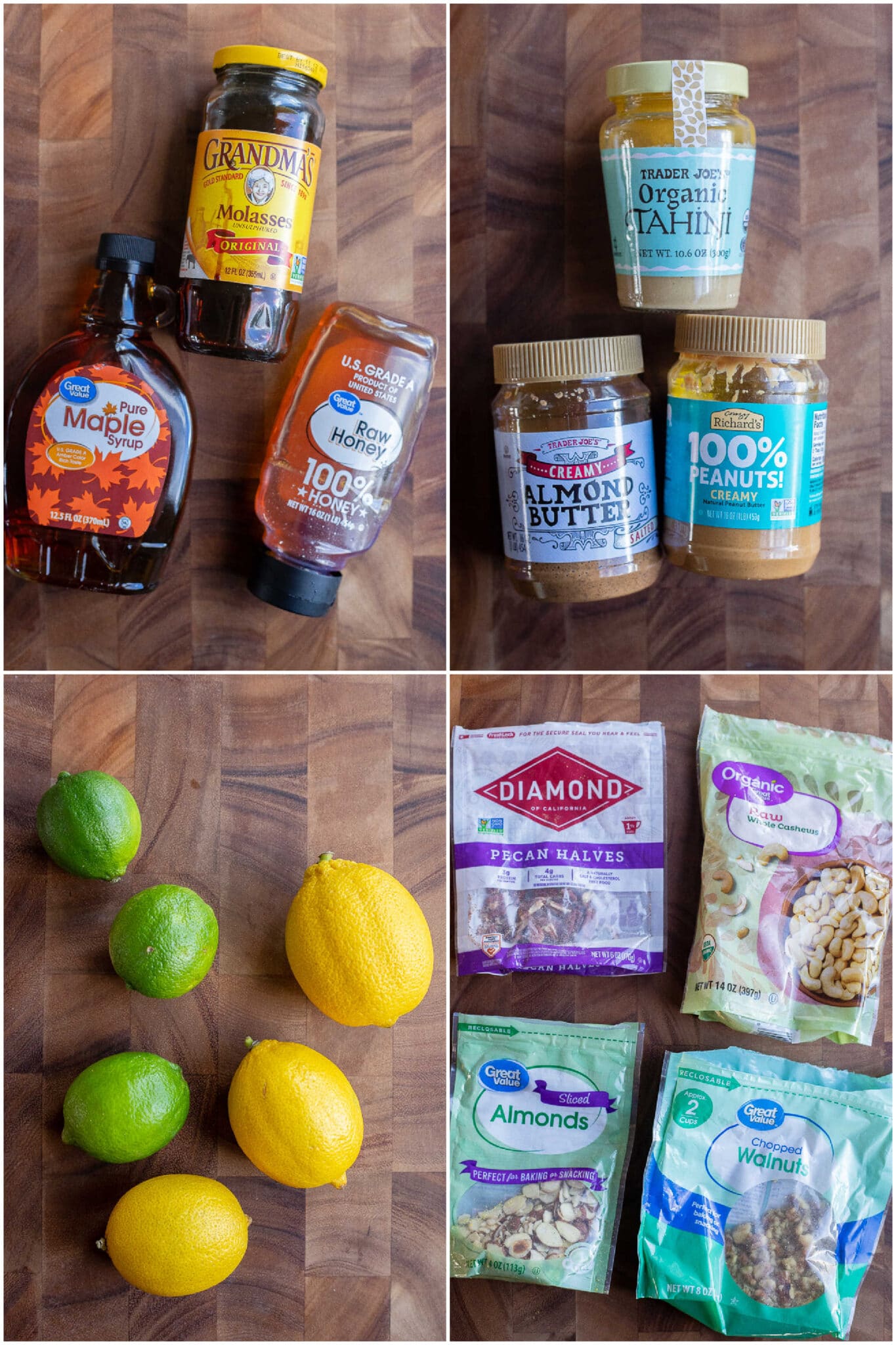
NUTS/SEEDS
In addition to nut butters, I also love having regular nuts around for healthy snacking. We usually get a big container of mixed nuts, but my husband also loves peanuts that come in the shells.
Not only are nuts and seeds great for snacking, they can also be easily incorporated into everyday recipes. I like adding them to salads, baked goods, sauces like pesto and so much more.
NUT BUTTER
Nut butters can be good sources of protein and they contain healthy fats. They’re great to have around for sandwiches, sauces and so much more. I prefer to buy nut butters that don’t have any added sugar and sometimes I even make my own.
Peanut and almond butter are probably most commonly used, but these days there are all kinds of different nut butters out there, including: cashew butter, hazelnut butter, pistachio butter and even sun butter for people who are allergic to nuts. Tahini is another seed butter, made from blended sesame seeds, that I use in so many of my recipes.
MAPLE SYRUP/HONEY
Pure maple syrup is my go-to when I need a liquid sweetener. I love the flavor and it is great for using in baking recipes, for dressings and sauces or for just drizzling over pancakes in the morning.
Honey, date paste, agave syrup, molasses and corn syrup are also other liquid sweeteners that can sometimes be used interchangeably.
LEMONS/LIMES
Not everyone might see these two citrus fruits as kitchen staples, but I use lemons and limes In so many of my recipes. They’re budget friendly, have a long shelf life and add such a refreshing bite to most recipes. I really recommend using fresh lemons and limes, rather than the store-bought bottled versions, but that is just my preference.
Out of the two, I use lemons way more often, from anything to adding a squeeze into some water, baking lemon flavored muffins or using it in homemade salad dressings. Citrus fruits are tart and refreshing.
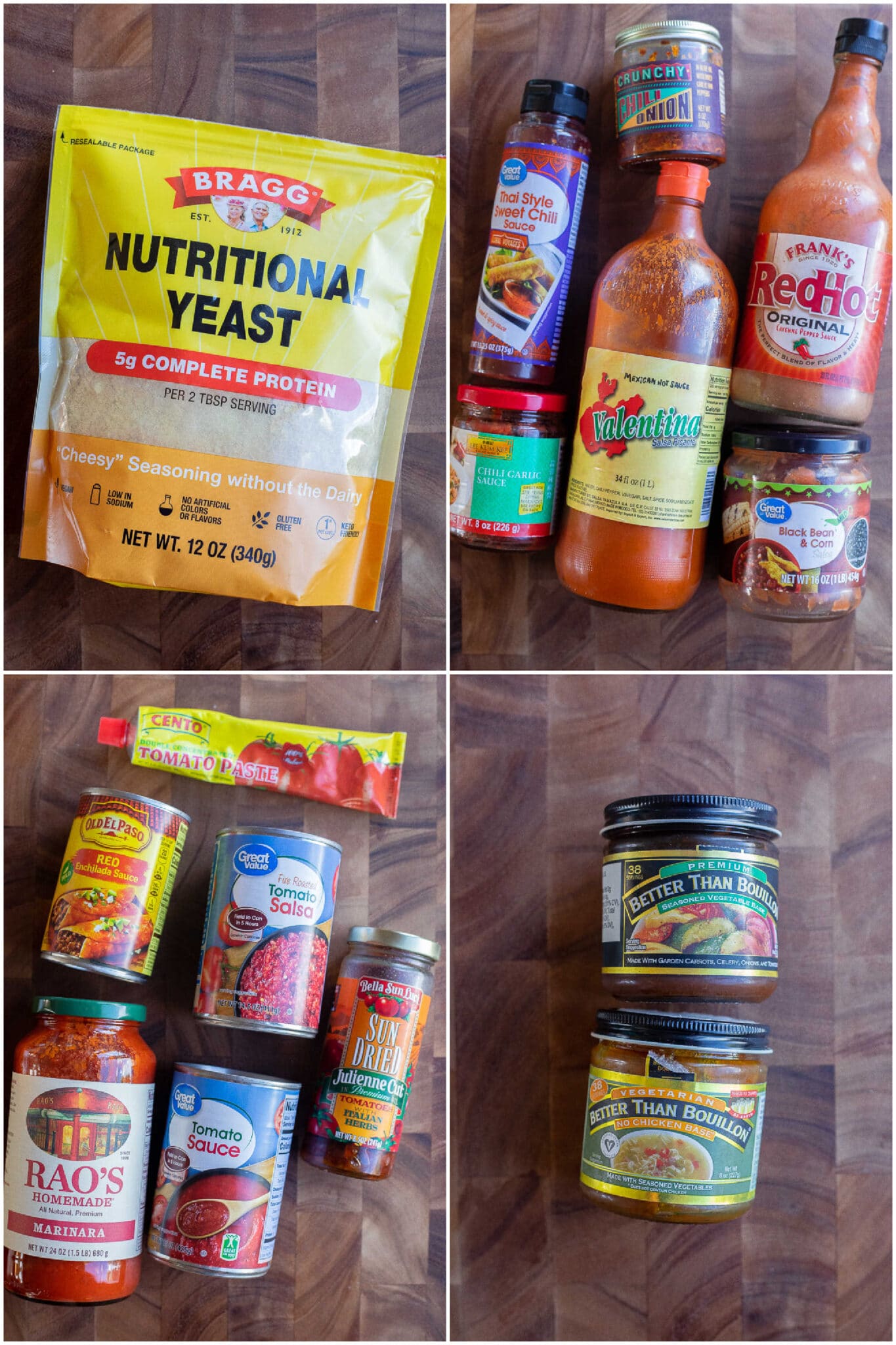
NUTRITIONAL YEAST
Nutritional yeast is an ingredient that is probably found in all vegan kitchens and most vegetarian ones. It is a deactivated yeast that is commonly used as a condiment because of its “cheesy” taste, texture and color. I use it in pasta, on popcorn, in sauces, on pizza and so much more.
TOMATO SAUCE/CANNED TOMATO
I like to keep a variety of canned tomato products on hand. Jarred marinara sauce is probably the most common one, but I also frequently use other canned tomato products like, tomato sauce, crushed tomatoes, diced tomatoes, tomato paste and even whole canned San Marzano tomatoes for certain recipes.
VEGETABLE BROTH
These days I mainly use a vegetable broth concentrate that then gets mixed with water or added right into soups. I find this to be much more economical for me than buying cartons of veggie broth at the store. The concentrated version lasts for a long time in the refrigerator and has a great depth of flavor. I usually just use a regular vegetable flavored one, but I do also have a vegetarian chicken flavored broth that gets used occasionally.
Broth can be used in soups and sauces, as a healthy drink when sick or you can use it instead of water when cooking grains, like rice, to add extra flavor.
SALSA/HOT SAUCE
Salsa and hot sauce are very different from eachother, but they are both spicy, tomato based condiments. I love dipping chips in salsa, but I also use it as a cooking ingredient in recipes like veggie burgers. It can help add flavor and bind ingredients together.
Hot sauce is usually vinegar based so it adds a nice tangy heat when used in recipes. I add it to sauces, dressings and marinades.
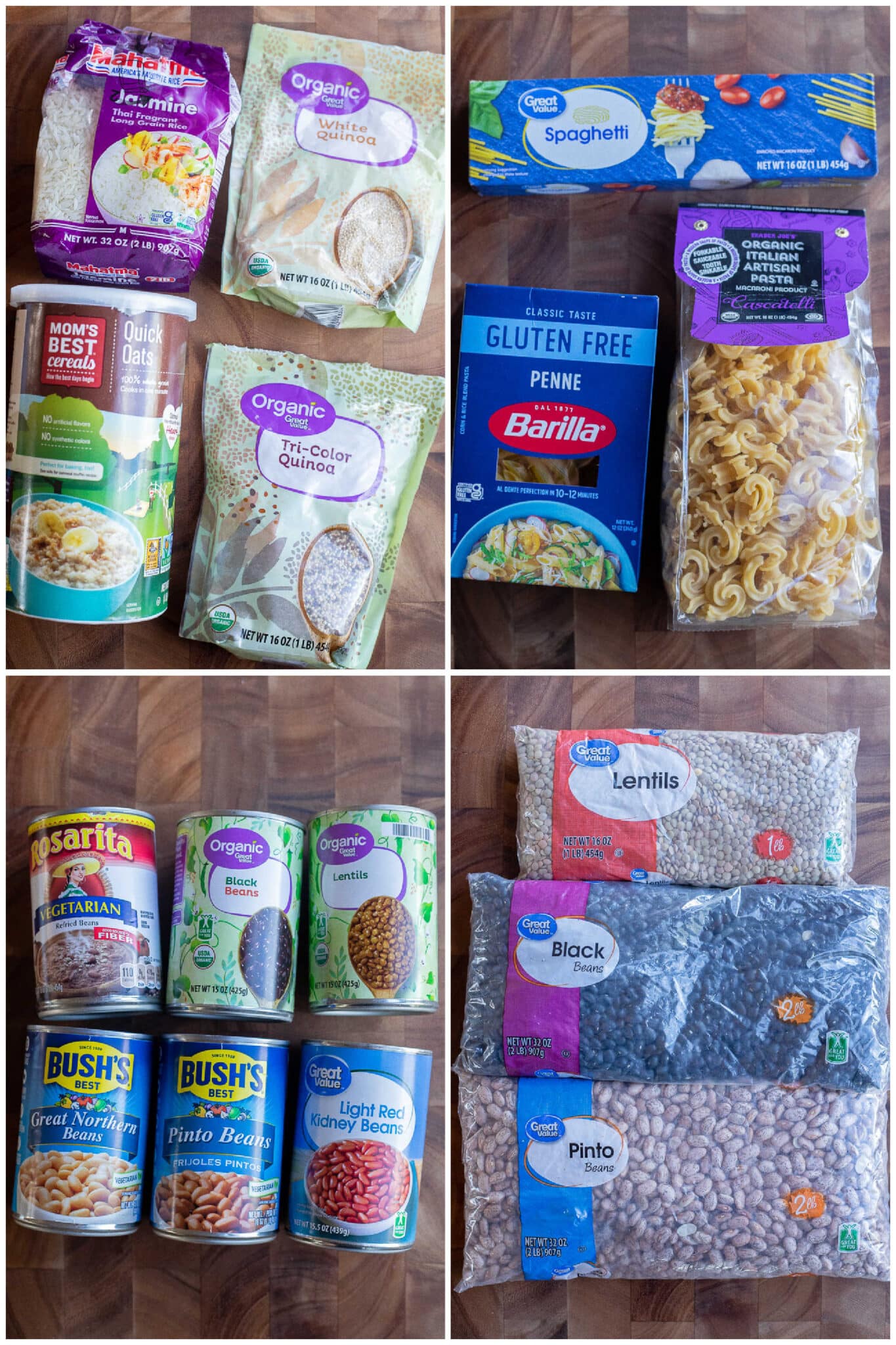
GRAINS
I always like to have a few different grains on hand because they’re great for using as side dishes, bulking up salads or adding to hearty bowls. Grains and whole grains both provide essential nutrients, but whole grains contain the whole kernal (which has a lot of nutritional benefits), whereas regular grains have been milled, which is a process that removes the bran and germ.
My most commonly used grains are rice (white, brown and wild), quinoa, corn, oats, millet and sorghum. Other common grains include: bulgar, barley, rye, amaranth, freekeh and farro. I tend to buy dried grains and cook them myself, but these days you can sometimes find packaged, pre-cooked grains at the grocery store, on the shelf or in the freezer aisle.
PASTA
Pasta is a staple in most households because it’s affordable, easy to prepare and people of all ages enjoy it. Pasta comes in many different shapes and sizes, and I like to keep a variety on hand. I do mostly use pasta that is made from refined wheat flour, but I am working on incorporating more whole grain pastas into my diet.
These days, there are many different types of pastas on the market that are healthier and not made from refined flour. These include pastas made from chickpeas, corn, rice, quinoa, lentils and peas. I would also include couscous in this category. I love using the small couscous for a quick and easy side dish.
BEANS (DRIED AND CANNED)
As a vegetarian, beans are probably one of the most used ingredients in my house. I use them in everything including: soup, salads, dips and so much more. I mostly cook with canned beans, because they are so convenient, but many people cook dry beans from scratch.
Beans that I always like to have on hand include: pinto beans, black beans, white beans, lentils, black-eyed peas, kidney beans, garbanzo beans, soybeans (edamame), green beans and peas. Other beans that I use occasionally include: lima beans, anasazi beans, mung beans, cranberry beans and adzuki beans.
TORTILLAS
I try to always stay stocked up on both flour tortillas and corn tortillas. Flour tortillas are great for burritos, quesadillas and wraps, while I like to use corn tortillas for tacos, homemade chips and adding to Mexican inspired casseroles.
BREAD
Bread comes in many forms, including: sandwich bread, pita bread, bagels, english muffins, buns and so much more. We regularly consume bread products and always have a few different varieties on hand.
TEA/COFFEE
I’m personally not a coffee drinker, but I do have a fully stocked tea cupboard. My husband drinks coffee, while I stick to hot and iced herbal teas, with green tea being a favorite.
BAKING STAPLES
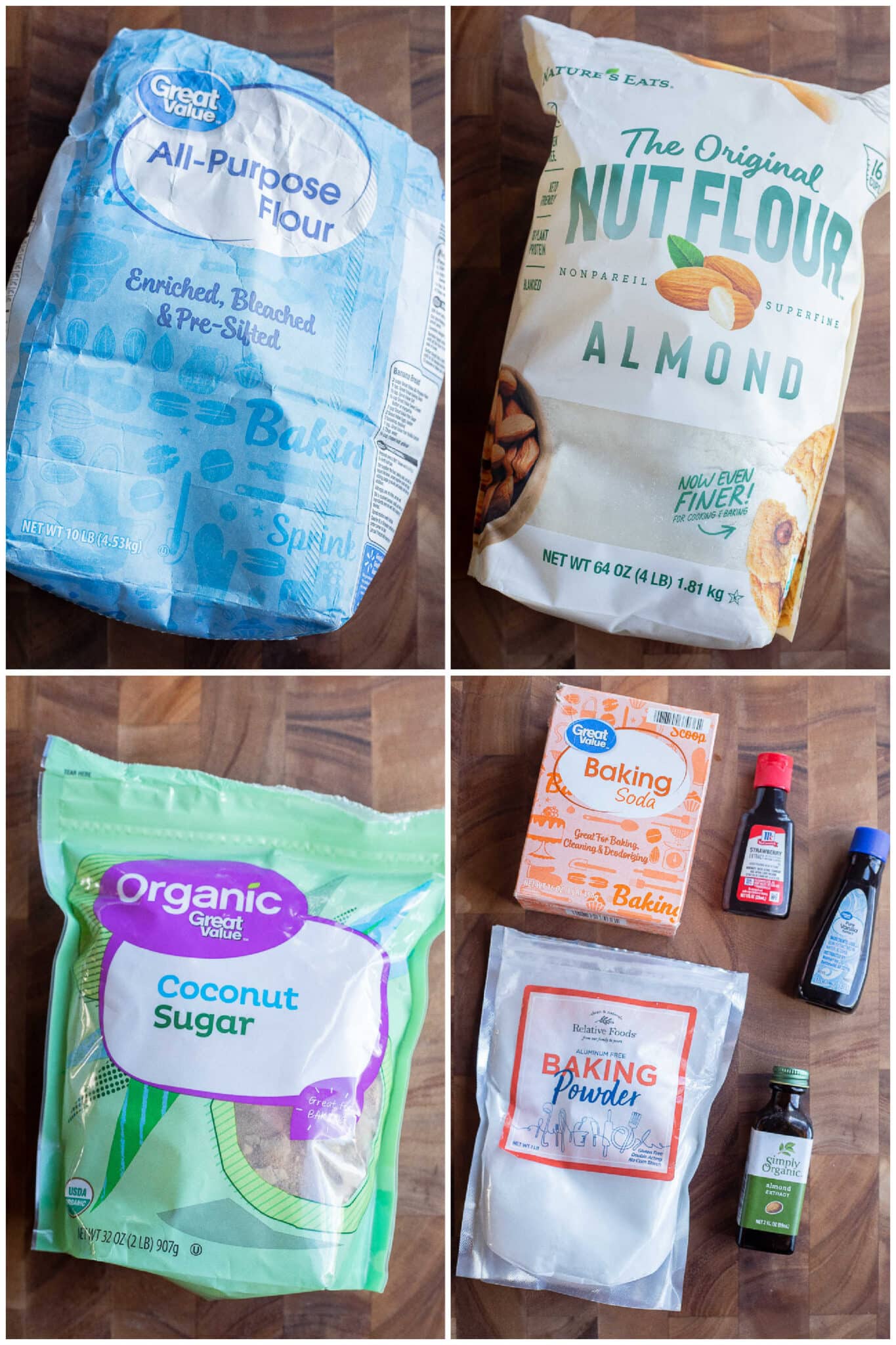
FLOUR
There are many different types of flours out there these days. I do primarily use white, all purpose flour, but also do regularly cook with whole wheat flour, self-rising flour and almond flour. If gluten free, they have lots of great gluten free flour mixes out there.
Other, lesser used, flours include: coconut flour, semolina, bread flour, cake flour, pastry flour, barley flour, buckwheat flour and rice flour, just to name a few.
SUGAR
I usually have a few different types of sugar on hand, Including: white cane sugar, brown sugar, powdered sugar and coconut sugar. When possible, I try to do most of my baking using coconut sugar or organic cane sugar.
BAKING POWDER + BAKING SODA
Baking powder and baking soda are staple ingredients for baking. Lots of baking recipes call for both, while some only use one or the other.
Personally, I only purchase baking powder that is aluminum free because I swear I can taste the difference!
EXTRACTS
Extracts are super concentrated flavors that are usually used in baking recipes. Vanilla extract is probably the most popular flavor of extract, but it does come in other flavors, including: almond, maple, strawberry, lemon, anise, chocolate, coffee and coconut.
I try to keep vanilla, almond, strawberry and maple on hand, but mostly just use vanilla.
REFRIGERATED
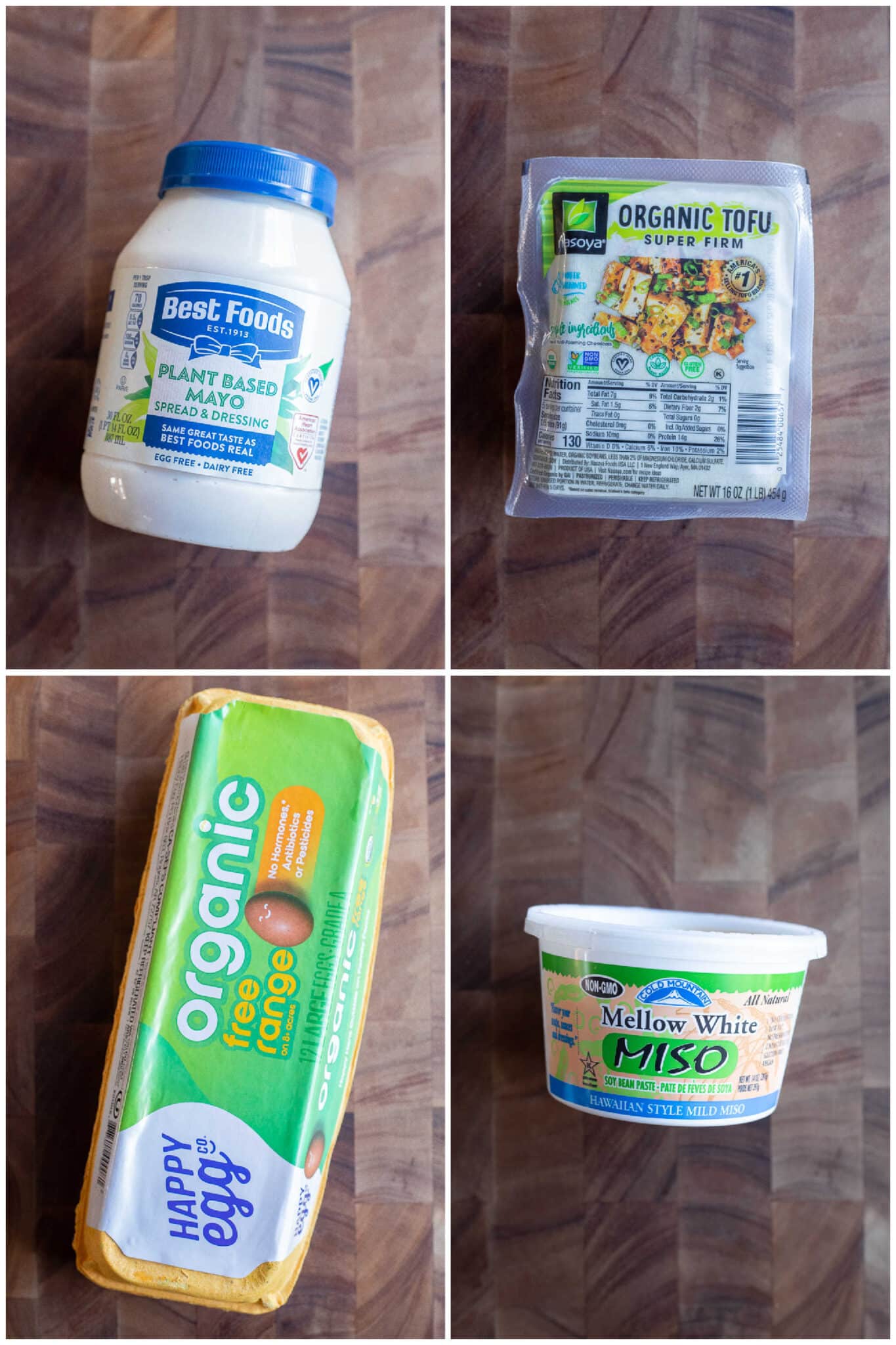
MAYONNAISE
I know that not everyone likes to use mayo in their recipes, but I personally don’t have a problem with it. I do, however, mostly only use the plant based mayo because I prefer the taste. I’m not someone who uses it on sandwiches, but I do like to have it around for dressings, sauces and recipes like chickpea salad. Yogurt can usually be used in place of mayo though.
MISO PASTE
Miso paste is made from fermented soybeans and comes in a few different varieties, including: light yellow, red and white. Miso paste isn’t an ingredient that I use often, but I do like having it on hand when needed. It is a staple in Asian cooking and can be made into a delicious broth.
I mainly use it for adding a nice saltiness to sauces and it has a great umami flavor that goes well in vegetarian pesto sauce.
EGGS
Eggs are categorized as being vegetarian and dairy free. They can be used in so many different ways, including as a breakfast food or a binder for baked goods. Eggs are high in protein and rich in nutrients, making them a great addition to a vegetarian diet. I enjoy them for breakfast when hard-boiled, scrambled or fried. I also add them to most of my baked goods and sometimes even as a binder in recipes like my vegetarian meatballs.
If you don’t eat eggs, there are many different ways to substitute eggs in both cooking and baking.
TOFU/TEMPEH
Both tofu and tempeh are made using fermented soy beans and are great sources of plant based protein. I don’t love the taste of tempeh, so I mostly use tofu, but both can usually be used interchangeably in recipes.
Tofu is very mild in flavor and comes in a few different varieties, like extra firm, firm and soft. I pretty much always use either extra firm or super firm tofu in my recipes because it has a great texture and really takes on added flavors well.
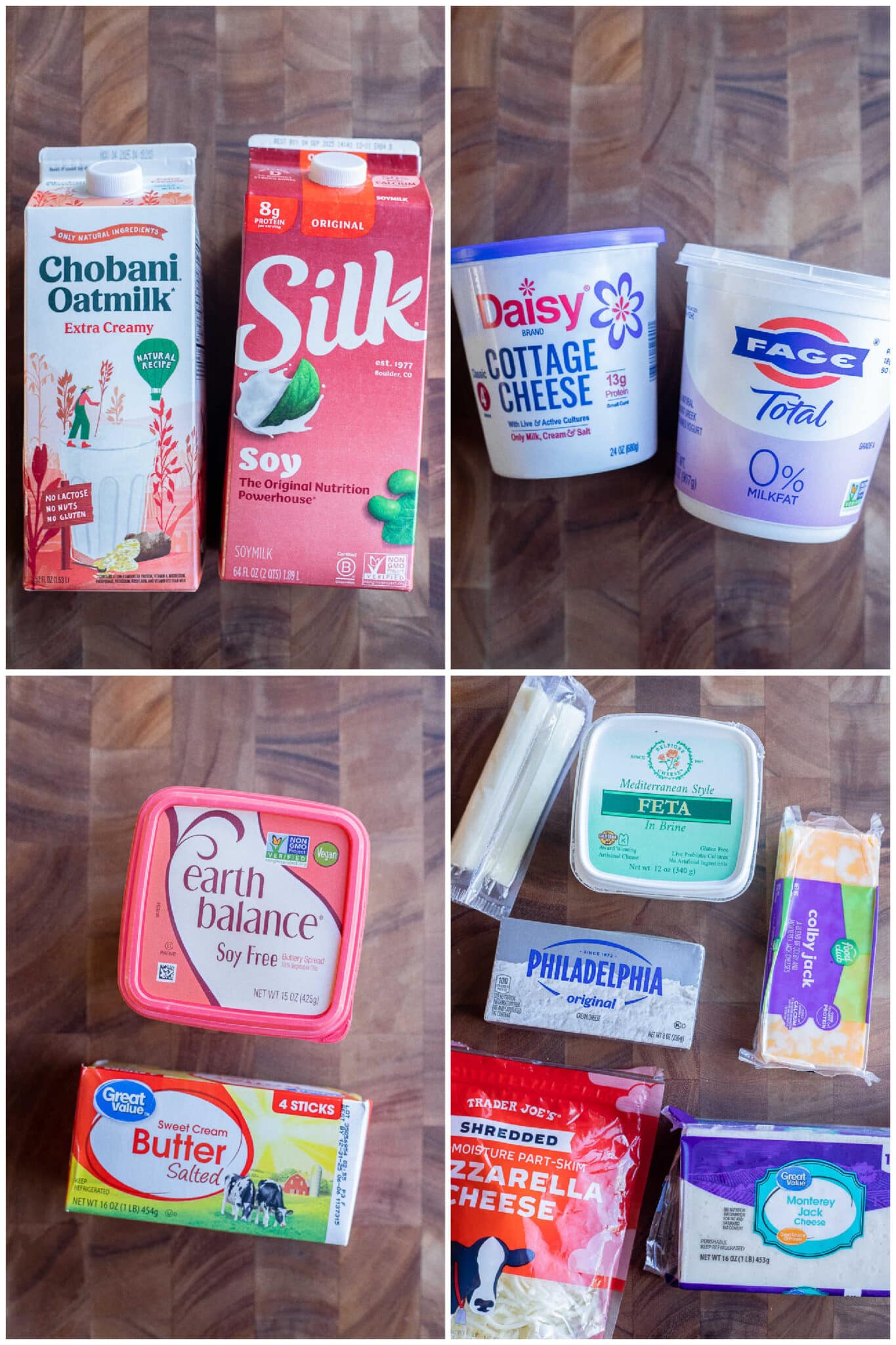
YOGURT
My favorite yogurt to keep on hand is plain, non-fat, Greek yogurt. I use it in so many things, including: smoothies, dressing, marinades, baking, or in place of sour cream. I also do use dairy free yogurt on occasion.
BUTTER
For a long time, I mostly used dairy free butter substitutes, like Earth Balance. But these days I usually use regluar butter. Most people recommend using salted butter for cooking and unsalted butter for baking, but I tend to just always use salted butter.
Butter is easiest to use when at room temperature, but some recipes call for melted butter instead. Oil can sometimes be substituted for butter in recipes.
CHEESE
Cheese is a great source of protein and calcium, especially when cooking vegetarian. Cheese comes in many different varieties and flavors, but my favorite to cook with include: cheddar cheese, Monterey jack, mozzarella, feta cheese and goat cheese. I prefer to buy a big block of cheese and grate it myself, but pre-shredded and pre-sliced cheeses are readily available at all grocery stores.
We also love having string cheese on hand for protein packed snacks throughout the day.
MILK
I usually keep a variety of milk on hand, for both cooking and drinking. My 9 year old loves whole milk, but I prefer using plant based milk in most recipes, like almond, oat and soy milk.
I also love using canned coconut milk for Asian inspired recipes. It is creamy, thick and has a nice coconut flavor to it. I mostly use it in sauces, but also bake with it occasionally.
VEGETABLES
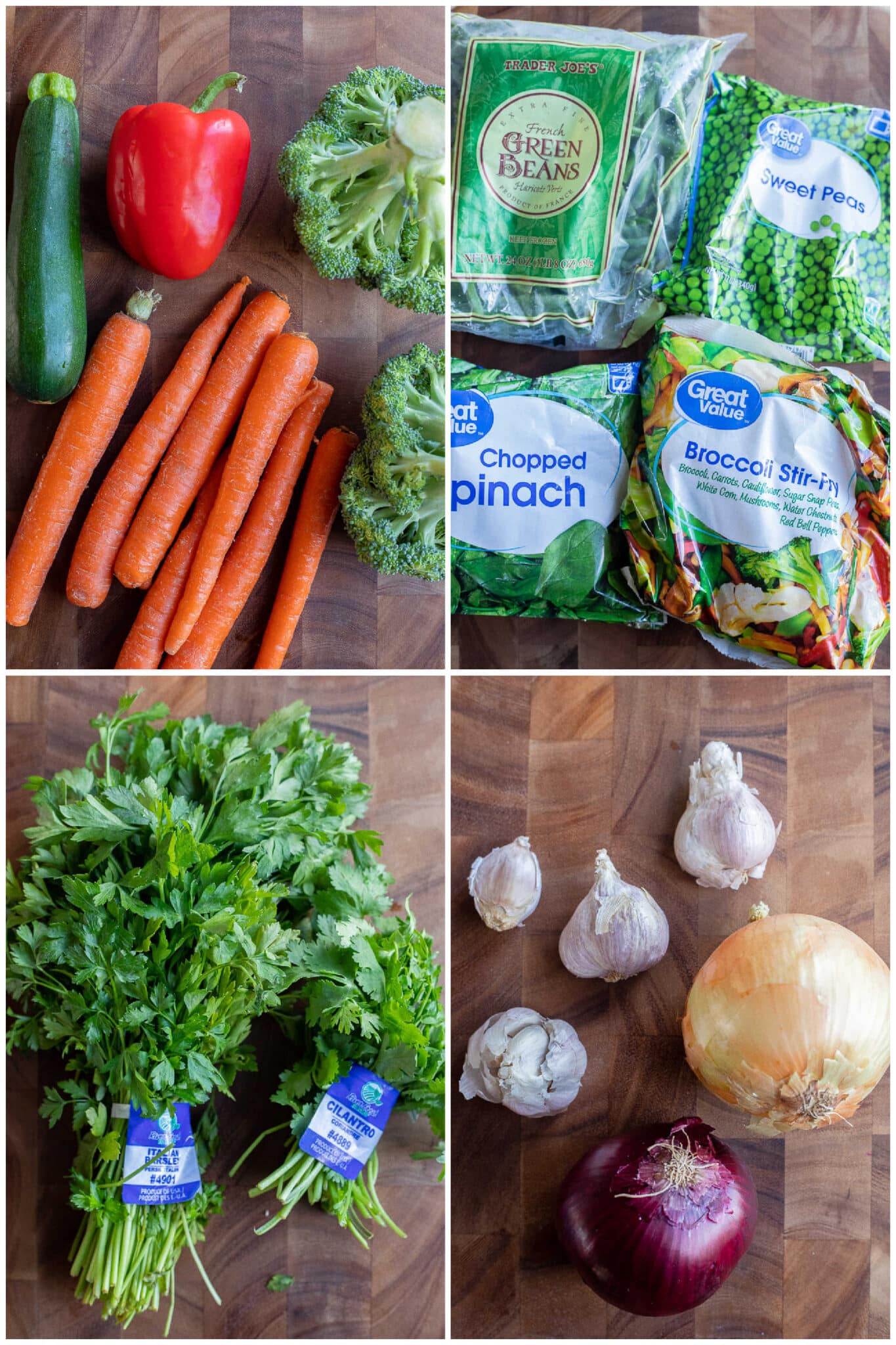
I decided to give vegetables their own section. I went back and forth and whether I should include them at all, but I do use veggies in most of my recipes so they have become staples in our house. I would suggest just keeping a good stock of vegetables that you use most often.
GARLIC + ONION
Garlic and onion are both vegetables in the onion family. They are aromatic flavor bases that I use in so many of my recipes. Garlic can be enjoyed raw or cooked, although most people cook it because the raw flavor is pretty strong. I love adding it to dressing, dips, soup and stir fry. I highly recommend buying fresh garlic and chopping it yourself, rather than using store-bought, pre-minced garlic, but that is just my preference.
Onions come in a few different varieties, but I use most of them interchangeably in my recipes. White and yellow onions are great for cooking, while raw red onion always makes an appearance in my fresh salad recipes. Sliced onion can be soaked for a few minutes in ice water if you want to tame down the flavor a bit.
FRESH HERBS
As well as keeping dried spices on hand, I also like to have a few fresh herbs. My most used fresh herbs are cilantro, parsley, mint and green onion. I either grow them in the garden each summer or purchase them from the grocery store weekly.
Fresh herbs add tons of earthy flavor to recipes, while also being great for quick garnishes.
REFRIGERATED VEGETABLES
Fresh vegetables that need refrigeration, include: celery, lettuce, cabbage, carrots, corn, broccoli, asparagus, cucumber and mushrooms.
SHELF STABLE VEGETABLES
Fresh vegetables that don’t require refrigeration, include: bell peppers, potatoes, sweet potatoes, tomatoes, winter squash, onion, garlic and zucchini.
FROZEN VEGETABLES
There are lots of different vegetables that you can buy in the frozen section. We mostly use frozen green beans, corn, peas, edamame and stir fry mixes that include a variety of different vegetables.

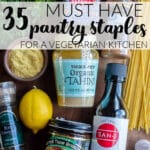
Leave a Reply